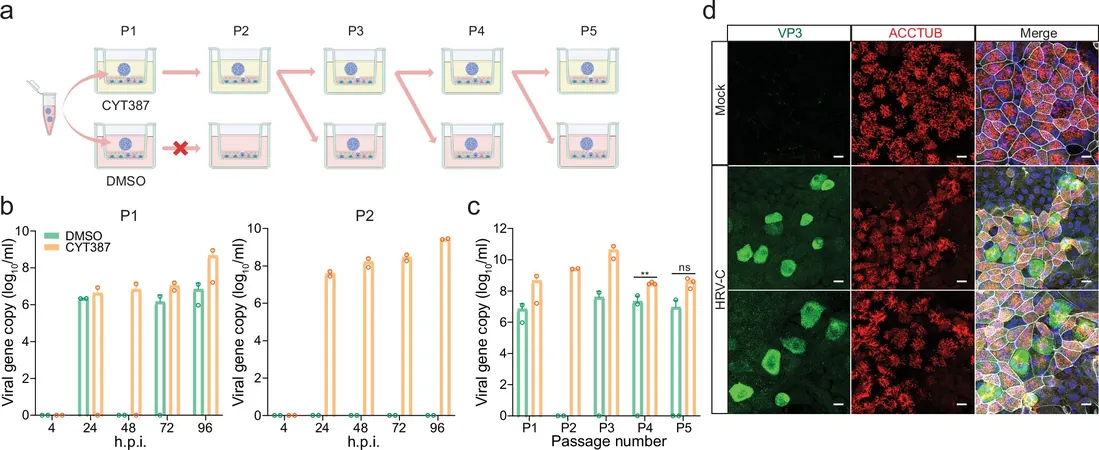
Groundbreaking Discovery: Human Respiratory Organoids Revolutionize Research on Hard-to-Cultivate Rhinovirus C!
2025-01-14
Author: John Tan
Groundbreaking Discovery: Human Respiratory Organoids Revolutionize Research on Hard-to-Cultivate Rhinovirus C!
In a remarkable breakthrough for virology, researchers have successfully utilized human respiratory organoids to cultivate human rhinovirus C (HRV-C), a virus that has long evaded conventional methods of cultivation. This pioneering achievement has profound implications for our understanding of respiratory viruses and accelerates the path toward effective vaccines and antiviral treatments. The groundbreaking results are detailed in the latest issue of Nature Communications.
Understanding HRV-C: The Cold Culprit
Human rhinoviruses are known to be the primary agents responsible for the common cold, and HRV-C, in particular, has caught the attention of researchers due to its association with more severe respiratory symptoms, including exacerbation of asthma and other chronic respiratory ailments. Currently, over 160 HRV serotypes exist, and more than 60 subtypes of HRV-C have been identified since 2006. Unfortunately, traditional laboratory techniques have been ineffective in cultivating these viruses, resulting in significant delays in drug and vaccine development.
The need for a novel approach to study HRV-C has been urgent, as public health officials continue to grapple with its impact on respiratory health globally. This new respiratory organoid model has emerged as a potential game-changer, allowing researchers to effectively study these often elusive viruses.
The First of Its Kind: A New Paradigm in Research
Through meticulous refinement of lung adult stem cells and nasal epithelial cells, the researchers established the world's first respiratory organoid culture system. This system enables the reconstruction and expansion of the entire human respiratory epithelium in a laboratory setting. The research team’s hard work has produced a robust model that not only aids in studying respiratory biology but also serves as a platform to combat respiratory diseases.
Key Findings and Future Implications
By utilizing their innovative organoid system, the research team successfully isolated and propagated HRV-C, providing valuable insights into the virus-host interactions. Their findings were astonishing: both airway and nasal organoids exhibited a high susceptibility to HRV-C and were capable of isolating the virus from clinical samples. Interestingly, the study found that nasal organoids are more sensitive to HRV-C infection compared to airway organoids, suggesting a novel area of research into differential responses to viral infections.
Furthermore, the organoid-based model was shown to be effective for drug screening, paving the way for the research and development of targeted HRV-C vaccines and antiviral agents.
Professor Jane Zhou Jie emphasized the importance of this research in advancing the field: "Our findings highlight the unique capability of respiratory organoids for studying HRV-C, elucidating potential pathways for vaccine and antiviral development."
A New Era for Virology Research
According to Professor Kelvin To Kai-wang, this study reinforces the University of Hong Kong's commitment to scientific innovation and has the potential to influence public health policies significantly. Professor Yuen Kwok-Yung called this a "landmark study,” stating its pivotal role in addressing and understanding this common cold virus.
This landmark discovery not only sets the stage for combating HRV-C but could revolutionize how researchers approach other challenging and previously uncultivable human viruses. The future of respiratory illness research looks promising as scientists harness the power of these respiratory organoids in pursuit of effective treatment options!
Stay tuned for more updates on this exciting research and its potential to change the landscape of virology forever!




 Brasil (PT)
Brasil (PT)
 Canada (EN)
Canada (EN)
 Chile (ES)
Chile (ES)
 Česko (CS)
Česko (CS)
 대한민국 (KO)
대한민국 (KO)
 España (ES)
España (ES)
 France (FR)
France (FR)
 Hong Kong (EN)
Hong Kong (EN)
 Italia (IT)
Italia (IT)
 日本 (JA)
日本 (JA)
 Magyarország (HU)
Magyarország (HU)
 Norge (NO)
Norge (NO)
 Polska (PL)
Polska (PL)
 Schweiz (DE)
Schweiz (DE)
 Singapore (EN)
Singapore (EN)
 Sverige (SV)
Sverige (SV)
 Suomi (FI)
Suomi (FI)
 Türkiye (TR)
Türkiye (TR)
 الإمارات العربية المتحدة (AR)
الإمارات العربية المتحدة (AR)